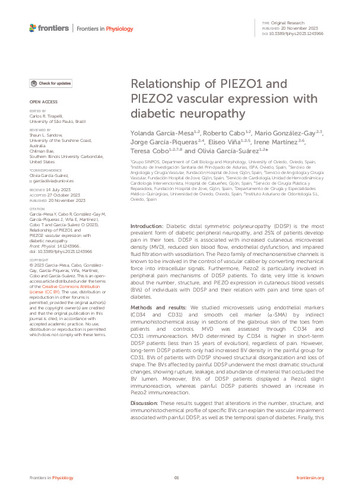Relationship of piezo1 and piezo2 vascular expression with diabetic neuropathy
Fecha de publicación:
Versión del editor:
Citación:
Resumen:
Diabetic distal symmetric polyneuropathy (DDSP) is the most prevalent form of diabetic peripheral neuropathy, and 25% of patients develop pain in their toes. DDSP is associated with increased cutaneous microvessel density (MVD), reduced skin blood flow, endothelial dysfunction, and impaired fluid filtration with vasodilation. The Piezo family of mechanosensitive channels is known to be involved in the control of vascular caliber by converting mechanical force into intracellular signals. Furthermore, Piezo2 is particularly involved in peripheral pain mechanisms of DDSP patients. To date, very little is known about the number, structure, and PIEZO expression in cutaneous blood vessels (BVs) of individuals with DDSP and their relation with pain and time span of diabetes.
Diabetic distal symmetric polyneuropathy (DDSP) is the most prevalent form of diabetic peripheral neuropathy, and 25% of patients develop pain in their toes. DDSP is associated with increased cutaneous microvessel density (MVD), reduced skin blood flow, endothelial dysfunction, and impaired fluid filtration with vasodilation. The Piezo family of mechanosensitive channels is known to be involved in the control of vascular caliber by converting mechanical force into intracellular signals. Furthermore, Piezo2 is particularly involved in peripheral pain mechanisms of DDSP patients. To date, very little is known about the number, structure, and PIEZO expression in cutaneous blood vessels (BVs) of individuals with DDSP and their relation with pain and time span of diabetes.
ISSN:
Patrocinado por:
The authors declare financial support was received for the research, authorship, and/or publication of this article. This research was supported (in part) by the Intramural Research Program of the University of Oviedo (PAPI-20-EMERG-13).
Colecciones
- Artículos [36410]
- Morfología y Biología Celular [167]
Ficheros en el ítem





